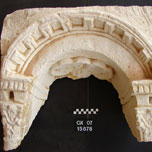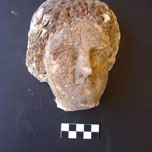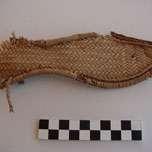Oxyrhynchus is an extensive archaeological site near the modern-day city of El-Bahnasa (in the Al-Minya governorate, Egypt). It is located approximately 160 kilometres south-southwest of the city of Cairo, on the left bank of the Bahr Yussef, a branch of the Nile that now terminates in the Fayum oasis.
The ruins of Oxyrhynchus were discovered and identified by Vivant Denon, one of the French scholars who accompanied Napoleon Bonaparte on his Egyptian campaign (1799-1802). The first excavations were undertaken in 1897 by Bernard P. Grenfell and Arthur S. Hunt, two Englishmen who travelled to the site when they heard news of a large number of papyri found there. Their excavations unearthed many thousands of papyri, mostly written in Greek and dated to the Roman period, and the discoveries they made are studied to this day by the Egypt Exploration Society, with a substantial number of items now housed in the Ashmolean Museum in Oxford. After the initial excavations, Oxyrhynchus attracted several Italian and English missions up to the 1930s, when official efforts were interrupted for a period of fifty years. Unfortunately, activity did not stop during this time. Numerous looters and treasure-hunters ransacked the site and many antiquities unearthed in those years have since been identified in private collections and public museums. Today, the museum thought to house the most antiquities from Oxyrhynchus is the National Museum of Antiquities in Leiden, in the Netherlands.
In 1982, the Egyptian Antiquities Organization received news that looters were emptying a significant tomb at El-Bahnasa. Successfully bringing the looting to a stop, they initiated official excavations of a large necropolis with tombs from the Saite, Greco-Roman and Christian periods. In 1992, the scope of the discoveries persuaded the Egyptian Antiquities Organization to seek a European partner with whom to continue the work, and they chose the University of Barcelona.
In 1992, the Egyptian Antiquities Organization and the University of Barcelona (UB) set up the Joint Archaeological Mission to Oxyrhynchus, under the leadership of Dr. Josep Padró i Parcerisa. Following existing regulations on excavation work, the UB built a residence for researchers and the site’s first storehouse for antiquities. Opened in 1999, the building stands within the archaeological site and belongs to the UB for the duration of the mission’s work. The land on which the building stands, however, remains the property of the Egyptian Antiquities Organization (today the Supreme Council of Antiquities). In 2002, the mission fell exclusively to the University of Barcelona.
In 2003, the UB and Egypt’s Supreme Council of Antiquities, which preceded the Ministry of State for Antiquities, collaborated in an exhibition on Oxyrhynchus that visited the Egyptian Museum in Cairo, the Greco-Roman Museum in Alexandria and the Coptic Museum, also in Cairo. In 2008, the mission also took part in an exhibition organized by the Spanish Ministry of Culture at Cairo’s Egyptian Museum. In 2007, on the occasion of a colloquium on Oxyrhynchus held in Cabestany (southern France), a photographic exhibition was organized, which later travelled to the Archaeological Museum of Barcelona, in 2009-2010, the Fundació Bosch i Cardellach in Sabadell, in 2010, and the Egyptian Cultural Centre in Paris, also in 2010.
The archaeological work of the UB at Oxyrhynchus has drawn on the collaboration of many private and public institutions over the years. In addition to the Supreme Council of Antiquities, these include the University of Cairo, the University of Montpellier III Paul-Valéry, the Catalan Egyptology Society, the Archaeological Museum of Barcelona, the Spanish Ministry of Culture, the Catalan Ministry of Culture, Rovira i Virgili University, the Catalan government’s Directorate-General for Research, through the Research Group on Classical, Protohistoric and Egyptian Archaeology and the Catalan Institute of Classical Archaeology, and the Terre d’Égypte.

















